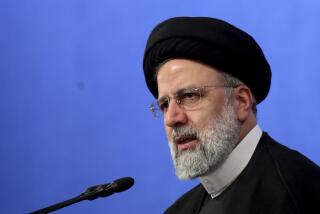IAEA may end Iran reactor funding
- Share via
PARIS — The international community tentatively decided late Wednesday to halt financial support for a controversial nuclear reactor in Iran that could be used to help produce plutonium for atomic bombs, but to continue to fund seven other Iranian civilian nuclear projects.
The decision to stop funding was a victory for Western countries that suspect Iran’s ultimate goal in its nuclear program is to build a bomb.
Under the deal tentatively agreed on by the 35-member board of governors of the International Atomic Energy Agency, the United Nations’ nuclear monitoring arm, the Islamic Republic would continue to receive technical assistance for its civilian nuclear projects such as nuclear medicine, but would not receive money for the heavy-water reactor under construction near the town of Arak.
The withdrawal of funding, however, will be handled in a discreet manner and without a formal vote, which might divide the board.
“The majority were uncomfortable with going ahead with that project,” said an official close to the IAEA.
“But many were also concerned about setting a precedent; they are worried that their project could be denied next,” the official said.
The issue will come up at today’s meeting of the IAEA board of governors in Vienna. The board must approve technical assistance projects carried out by the agency, which also inspects nuclear plants for safety and tracks the proliferation of nuclear weapons.
Technical assistance to Iran, which totals less than $1 million a year, represents only a sliver of the $70 million that the agency spends on technical projects. The U.N. nuclear agency funds more than 800 projects in 134 countries, according to agency officials.
The debate in Vienna this week highlighted again the two most difficult issues for the agency: the murkiness of the line between civilian and potentially military nuclear projects and the tensions between the nuclear “haves” and “have nots.”
The Arak plant, much like the uranium enrichment plant that Iran is building at Natanz, has a legitimate peaceful use.
But it also can be used to make fissionable material for a bomb.
Although the IAEA can conduct inspections to ensure that these plants are used only for peaceful purposes, the possibility remains that Iran could follow North Korea’s model, leaving the Nuclear Nonproliferation Treaty, expelling inspectors and beginning to produce fissionable material for a nuclear weapon.
In deference to the concerns of developing nations, the compromise avoided criticizing Iran or the project directly. Leading the charge on Iran’s behalf was Cuba, which leads the Non-Aligned Movement, the 115-member organization that represents developing countries.
Under the compromise, the Arak project will be left off the biennial list, leaving open the possibility that the funding would be revived later, although Western diplomats indicated that the project was unlikely to be funded again.
“The technical cooperation program is a two-year-program, so in theory the question could be put forward again,” a Western diplomat said. “But quite frankly, if we have the same situation as today, I cannot imagine that the board will approve it at that time either.”
The board reported Iran to the U.N. Security Council in February, saying Tehran had failed to respond fully to IAEA nuclear inspectors’ requests for information about its past nuclear program, and refused to adhere to a board resolution asking it to suspend uranium enrichment.
The Security Council appears unlikely to come to agreement in the coming weeks on sanctions. Russia and China have backed Iran and been reluctant to endorse sanctions, which they fear could push Iran to leave the nonproliferation treaty.
The controversy about Iran’s Arak project is not new. In past resolutions, the IAEA board of governors has asked Iran to reconsider the project.
Heavy-water reactors are of concern because their spent fuel rods can be reprocessed into plutonium that can be used for nuclear bombs.
Pakistan and India use similar heavy-water reactors to make plutonium for bombs for their nuclear weapons program, according to nuclear experts.
Iran also is slowly building a plant to enrich uranium, a second method that can be used to obtain fissile material that can be used in a bomb. But the plant at Natanz has run into difficulties with the delicate centrifuge technology.
Plutonium can be produced using a reprocessing plant, a somewhat less fragile process. But plutonium is highly radioactive and much more hazardous to workers.
Iran is not known to have a reprocessing plant, and Iranian officials assert unequivocally that the Arak plant would be used only to make radioactive isotopes, such as those used in nuclear medicine.
*
Times staff writer Elisabeth Penz in Vienna contributed to this report.
More to Read
Sign up for Essential California
The most important California stories and recommendations in your inbox every morning.
You may occasionally receive promotional content from the Los Angeles Times.













